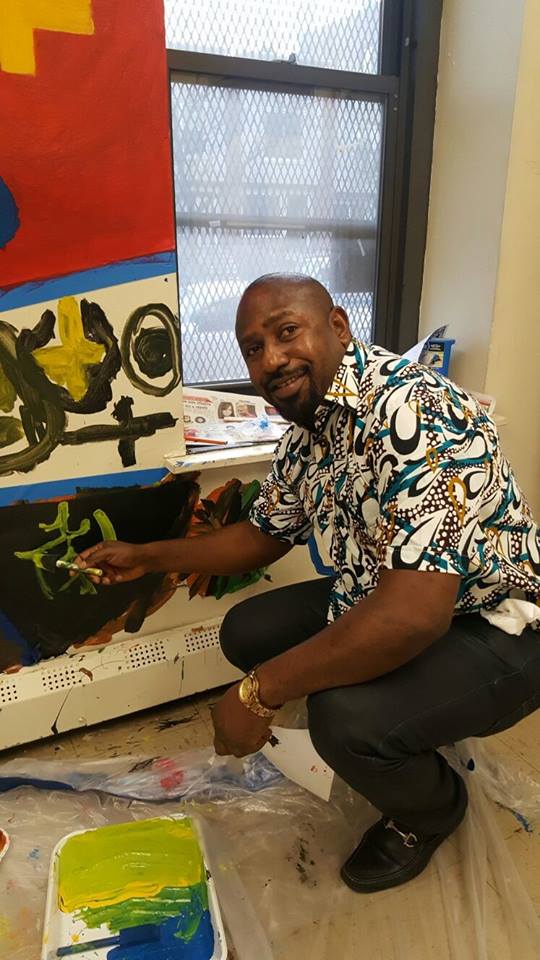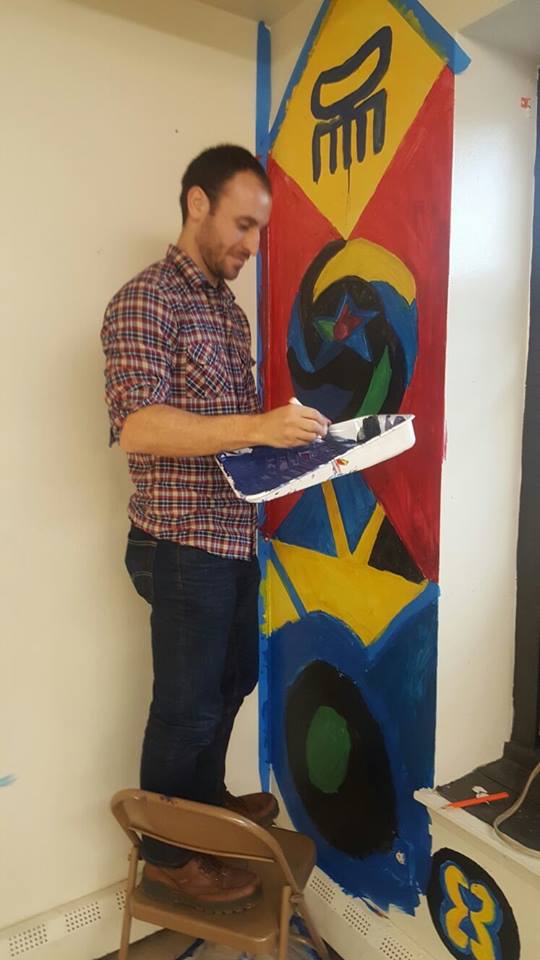Starting with one conversation on the environment, Mambo Tse has seen how Community Conversations can bring people together, and how those conversations can lead to other fruitful projects. From discussions on immigration and food insecurity came an idea for project exploring the community’s relationship to African history and how it impacts them today, which was funded by an HNY Action Grant.
In this interview, Mambo shares how public humanities programming has helped her group engage with youth across New York City, in classrooms and afterschool programs, as well as the general public and elderly populations at senior centers discussing topics related to the environment, immigration, and more.
HNY: How did you first learn about Humanities New York, and what motivated you to get involved?
Mambo: In high school, I had a teacher who called herself a “humanities expert.” I never really knew what that meant. Of course, I was in her humanities class and all that. She had a dance company I was in, and she used to take us to the Senate in Austin, Texas (I grew up partially in Dallas). We would perform and then she would do these speeches, from the African-American perspective, on whatever was happening at the moment. It didn’t fully click until I started my work at Sirens and started thinking about doing something outside of just dance.
HNY: Right, so, tell us about Sirens, and why the company has that poetic name.
Mambo: Sirens–Protectors of the Rainforest was started by five first-generation African dancers at the P.S. 261 school with the idea of of giving back to the community through dance. The use of “Siren” comes from the West African and South African regions, in these stories there is a creature called Mami Wata who is usually described as a female water deity associated with healing and fertility, but is also known to lure people to her, much like the Greek Sirens. The name Protectors of the Rainforest came later from our conversations in the community. The school is located in a food desert, and the children were very disconnected from the food they ate, so we started a small garden on the property. People in the community walked by our garden and told us it was like “a little rainforest in the desert.” So we decided we would be the protectors of it, and what it means to the community.
The dancing we do is a great way to share culture, but people need to start talking more to each other too, especially here in New York. We have a sense of a protected, personal space in New York, but when you get people together, they start talking, no matter what. We started thinking of ways to present history to the community, specifically African history. And we started looking for funding to produce this sort of work and, lo and behold, Humanities New York pops up and we thought: This works for us. This does exactly what we want to do.

My partner said let’s do an African history conversation so we can introduce the people who live in this neighborhood to better understand black history and heroes and get away from negative connotations of black history. Because it can be traumatizing at times. We have to find a way of not just having conversations but healing people, so to speak. The best way to heal people is letting them get whatever is on their chest, off. I think a lot of problems, physical and emotional, stem from suppression. So we scheduled an appointment with Humanities New York and we thought the appointment was at your office [laughs] and not a phone conversation. So this guy was calling us on the phone and I was like, “We’re coming up in the elevator.” [laughs] I think it was you actually.
HNY: It was me. [laughs]
As we learned more about HNY’s Community Conversations program, I knew that was exactly what we were trying to do. Our first conversation was on the environment. People think that low-income people don’t care about the environment, which is a huge fallacy. Poor people are the ones that have to live in the houses with lead paint, the neighborhoods that used to be landfills or chemical plants. They face pollution every day, from plastic bags on the street to the factories spewing out toxic chemicals. They are on the front lines of what we are doing to our environment in cities, so for them the environment is something they have to think about every day. It wasn’t surprising to me that this conversation has been, by far, our best attended. Something we didn’t expect, though, we had people come in from other zip codes to Bedford-Stuyvesant who wanted to know about the food supply. I think that what the environment is, means very different things to different people.
HNY: You used the term “food desert” earlier, can you say a bit more about that?
Not only was our environment “Conversation” held in a food desert, but the neighborhood also has one of the biggest community gardens in NYC–right where many of the residents are on SNAP (food stamps). That’s a big disconnect. We wanted that garden to be an oasis for the kids and the parents that came. Participants were talking about not having fruits and vegetables in the neighborhood. I come from a carry-your-food kind of family. So I always have a healthy snack on hand. And I had never really thought deeply about how a lack of healthy options affected the neighborhood. The best part about the conversation was that it wasn’t just people from the neighborhood. It was also people from co-ops, people from community gardens. It wasn’t just about the problem that way! It was also: well here are some solutions, these people have some small answers. They said: you can come to our garden, we have fresh fruit and vegetables. If you help us with the garden, you get food.
HNY: Solutions actually arose from the conversation?
Mambo: Yes, exactly. That was amazing in of itself and I really valued that. It was a very diverse mixture of people and everyone left feeling better after the conversation. After the success of that conversation we applied for a Vision Grant from Humanities New York for ARISE – African History, Past to Present, a project to build self-awareness by breaking down immigrant stereotypes in the Bedford Rehab Houses. There had recently been five shootings in the area, and several people had been assaulted so there was a lot of tension. We decided as part of the conversation to do a mural together to start the conversation, and with the help of the New York City Housing Authority, the NYPD Community Officer, and others we were able to get permission for the mural. The idea for painting a mural as part of the healing process come from Ghana, and South Africa, where after one hundred years of war they used community painting as a way to process the history and as a way to heal. And that was interesting. Over thirty people contributed to the wall mural. There were police officers, gang members, multi-generational families. It was normalizing the conversation, cops could talk to the gang members in a completely different context. It was about healing through art and conversation. That was incredible. The event was supposed to start at noon, I was told there were people who’d been waiting since 10:00 a.m. The excitement came from people lacking a space to turn for meaningful conversation. It creates what we call, in dance, a “cipher”–a space for people to just put out how they feel.
HNY: Could you tell me about the project you organized at Glenwood Senior Center?
Mambo: The immigration stories? That project was so amazing! Again, the perception you have of people, whether it’s your own personal bias or stereotypes, can be so different from the truth. My mind was completely blown away by all the different stories people shared at the Center. The people that come into these senior centers have lived these incredible lives, but they are entering this phase in their life when society doesn’t think they should have any input. What really brought about the immigration stories project was one of the Community Conversations we had on immigration. The number of people that showed up grew every time we held them; we used to host it in this small room, but we had to move it to the cafeteria to fit everyone in.

At the Senior Center they hold breakfast and lunch programs and they try to keep people interested and active between meals but mostly the seniors just come in, eat and leave, so we started the Community Conversations as a way to keep them here. Out of that we heard so many stories from many generations of immigrants, you could even see the historical changes in immigration policy and understand them just from listening to the stories told by participants. From all different perspectives, from the islands to overseas.
At first the conversations got very heated since few people in the conversations knew each other. We had Haitians, Dominicans, Native Americans, Asians–there was this one lady from St. Lucia, she got up and she said, “When I’m talking, you hear my Lucian accent, but you don’t know where I’ve been. You don’t know where I’ve lived. I speak Spanish, but you wouldn’t know it from looking at me. And the reason I speak Spanish is because when I left St. Lucia, I left with a Venezuelan family.” And that’s when I knew we needed to do something more with this, to talk to more people about their immigration experience.
HNY: And how did those conversations then lead to the “immigration stories” project?
Mambo: Out of the work we had been doing through HNY, I was able to get a mini-grant from Brooklyn Arts Council to record people’s personal stories. We’re in the process of finishing them and I’m excited to make them available soon. These are people who, well, no one had ever asked them, and now their story can be listened to by people all over the world, so for them, this is really empowering. We need to share more of our history, especially to the younger generations. They’re so enthralled, on computers. They don’t know who their neighbors are or where they come from.
Interview by Connor Goodwin, Program Officer and Nicholas MacDonald, Communications Manager
Keep up with us, join our newsletter.
Mambo Tse is known as a choreographer, artistic director and performance artist. For seventeen years, she has conducted many community engagement workshops on African dances, histories, music, and cultures globally. She is the founder of Siren–Protectors of the Rainforest and has taken her group on corporate sponsored tours around the United States and Canada. Siren–Protectors of the Rainforest is a private non-profit dedicated to preserving culture using music, dance, arts, and history as a platform to educate people about the benefits of reducing, recycling, and reusing.

